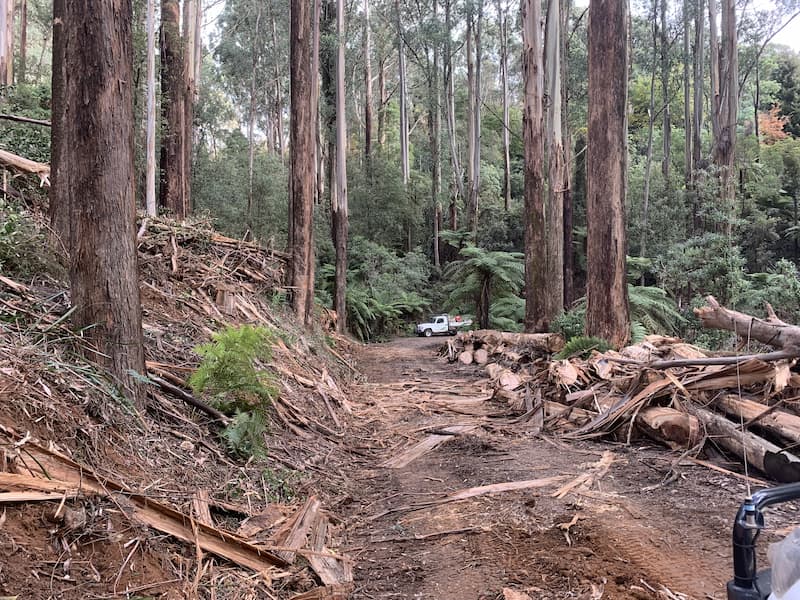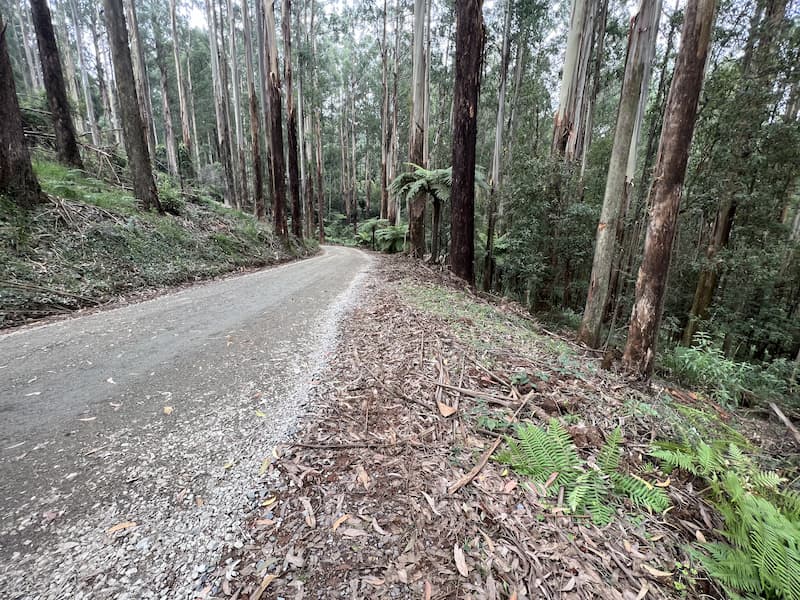More than 220 hectares of forested area was severely affected within the Dandenong Ranges National Park in the 2021 storms. In some areas, as much as 90% of the tree canopy blew over or snapped off. FFMVic’s Port Phillip region has led the recovery effort in the Dandenong Ranges. Partners include Park Victoria, Melbourne Water and local government.
Fallen debris from storm events is part of an essential natural cycle, with debris providing significant biodiversity value, including habitat for native wildlife. For the vast majority of the storm-impacted area, debris will be left where it fell. However, it will be treated or removed in limited high-risk areas where fallen debris presents a significant future bushfire risk or where it prevents access to the area for FFMVic firefighting crews. Where it is removed, it will be used where possible including for community firewood.
The purpose of works in these areas is to manage bushfire risk to protect communities and assets. Trees will not be felled or removed unless deemed hazardous.
Before clean-up

After clean-up

Where are works taking place to reduce risk?
Track 13, near Silvan Reservoir Park, Silvan.
For the latest updates on track closures within the National Park, visit https://www.parks.vic.gov.au/places-to-see/parks/dandenong-ranges-national-park
Following heavy rain in April 2024 works in the Bartlett Track, Olinda area have been delayed.
When will these works take place?
Works will take place from April 2024 and are expected to be complete by 30 May 2024, weather and forest conditions permitting.
What work is being undertaken?
Fallen debris is being removed from roadsides along key fire access roads and fuel breaks, including up to 40 metres off the tracks. All standing trees will be retained unless they are deemed unsafe and pose a danger.
These works will allow fire crews to respond more quickly, safely and effectively to a bushfire by removing obstacles to accessing the site. It will also ensure a safer work environment for crews conducting planned burns. This approach will minimise the impact of machinery on environmental values by enabling crews to conduct most of the work from the existing tracks.
Why are works taking place?
The post-storm condition of these areas would make controlling a bushfire very challenging and increases the potential damage and risk to the community.
Heavy fuels such as logs and branches can burn for a long time and result in a hotter, more active fire, making it difficult for firefighters to suppress it.
Before the June 2021 storms, planned burning was regularly used at these sites to reduce bushfire risk.
Although planned burning occurred in the area in May 2021, growth and storm damage has returned the bushfire risk in these areas to a high level.
Once this work is complete, effective and safe planned burning can resume where appropriate.
What is happening to the debris once it's removed from the Park?
Some debris will be made available for collection as firewood at a designated State Forest collection area near Powelltown.
Fallen hollow logs and rootballs have been provided for fish habitat along streams, as habitat in Lysterfield Lake Park, for Werribee Zoo animal enclosures and more.
What is the bushfire risk in the Dandenongs?
The Dandenong Ranges is heavily populated. Many people live in the forest with few escape routes.
The nearby Silvan Reservoir provides 82% of Melbourne’s drinking water. A fire in this area would significantly impact people, biodiversity and wildlife, this critical infrastructure and the local economy. For these reasons, the Dandenong Ranges has the highest bushfire risk in the Greater Melbourne region.
Apart from debris removal and planned burns, how do you manage fire risk?
We work year-round alongside partner agencies, local government and communities to develop and deliver the Joint Fuel Management Plan (JFMP).
As well as planned burning, we also slash, mulch or remove excess vegetation to lower bushfire risk.
How do you protect the environment during these works?
We prioritise the protection of environmental, biodiversity and cultural values during all recovery and bushfire risk reduction works. Protections include:
- excluding sensitive areas from works
- tree root protections
- approaches to minimising soil disturbance as much as practicable
- weed/pathogen transmission protocols
- identification of the feeding trees of possum species
- retention of remaining standing trees.
Useful links
Overall fuel hazard guide (PDF, 3.3 MB)
Find out more about the works to clean up the storm debris in these locations by clicking on the interactive map below.
The pins on the map show you:
- roadside works in purple
- broadacre works in orange.
If you zoom in, you will see the hatched area and the boundary of each treatment site.
Clicking on a pin or a hatched area, will provide you with information about a site, including:
- a unique site number
- the name of the location of where works are taking place, usually relating to a road or track
- which organisation they are being done for, usually DEECA and sometimes on behalf of a land manager
- a description of the status of the works, with an estimated start or finish date for the works (if available).
Please note that the hatched area on the map is the total site area. The area that timber is being removed from is generally only part of the site area.
The maps will be updated as value checks are finalised and assessed in the field.
Public Safety Zones will be put in place prior to works commencing on any site. This means that access will be restricted, ensuring everyone’s safety while heavy machinery is in the area. It is an offence to enter a Public Safety Zone.
Page last updated: 03/05/24